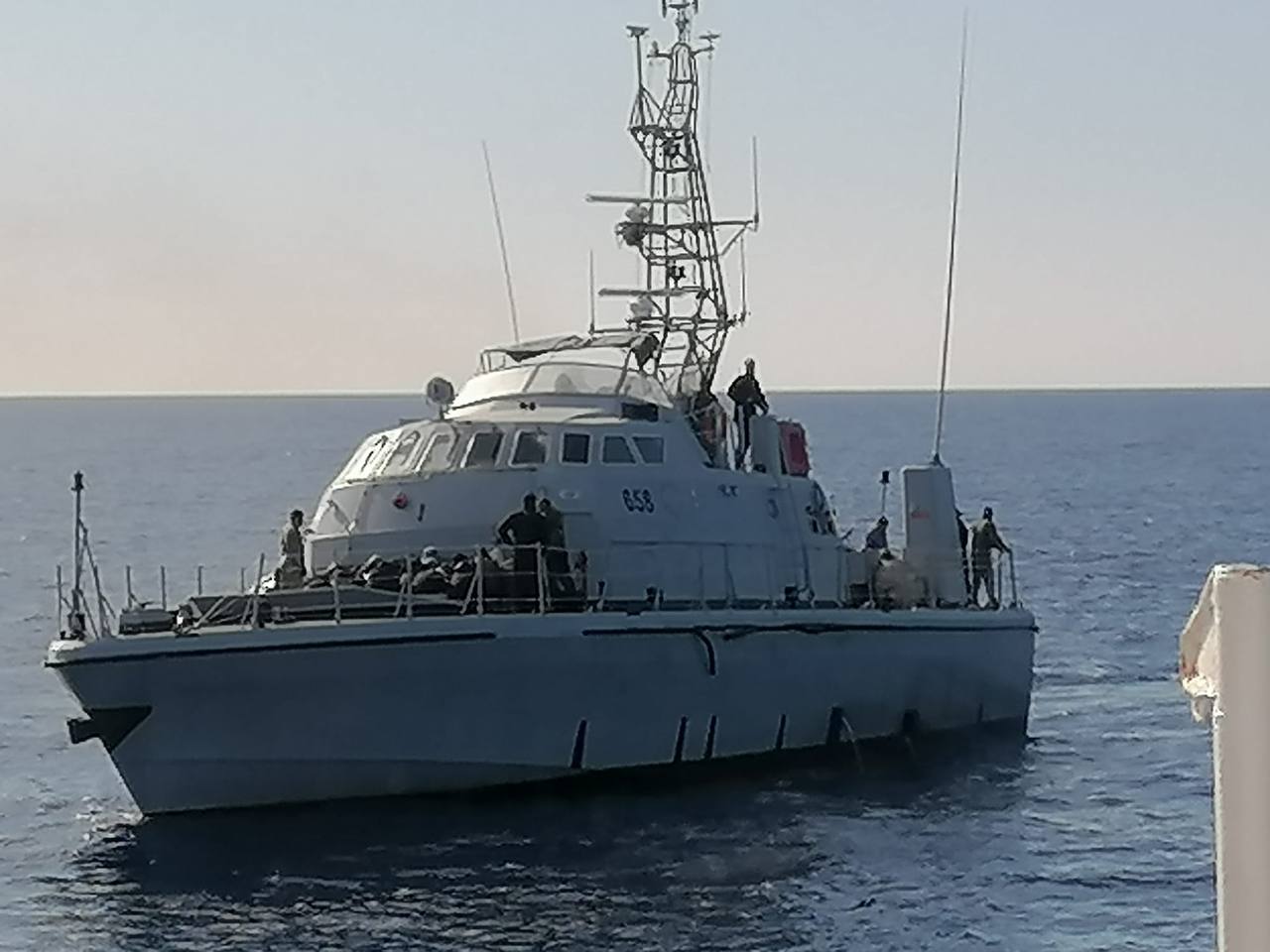On the evening of Wednesday, April 3, the MARE JONIO departed from the port of Syracuse for its sixteenth observation and rescue mission in the central Mediterranean. In the early hours of Thursday, April 4, it set course toward the Search and Rescue (SAR) zone where the so-called "Libyan authorities" operate.
At 1:45 PM and 3:16 PM, the vessel received email communications from ALARM PHONE reporting a boat in distress with engine failure and approximately fifty people on board, adrift in international waters—90 nautical miles south of the island of Malta and 95 miles north of the Libyan city of Al-Khoms.
At 3:57 PM, we heard radio communications on channel 16 VHF from an aircraft later identified as AS1227 BE20, ICAO: 4D206A, of the Armed Forces of Malta (AFM), which was broadcasting mayday relays for at least three incidents. It provided updated coordinates of the vessel in distress at position 34°18’ N - 014°09’ E. Despite repeated attempts, the aircraft did not respond to our calls.
At 4:26 PM, MARE JONIO informed the Italian Maritime Rescue Coordination Centre (IT MRCC in Rome) that we would set course for the indicated position to assess the situation of the vessel in distress.

At 4:35 PM, we sighted the boat in distress through binoculars and approached to assess the situation. It was a fiberglass vessel, overcrowded with people lacking any form of individual safety equipment, adrift with engine failure, and at imminent risk of sinking. Our Rescue Team began distributing life vests to everyone on board.
During these initial assistance efforts, however, a Libyan patrol boat approached at high speed. It was the 658 “Fezzan”, a Corrubia-class vessel formerly belonging to the Italian Guardia di Finanza and donated to Libyan militias in Tripoli by the Italian government in 2018. The patrol boat already had several dozen people on deck, presumably intercepted in previous maritime operations. The Libyan militiamen radioed the MARE JONIO, threatening us and ordering us to leave the vessel. At the same time, they began executing dangerous maneuvers around the boat in distress.
We responded over the radio that, in accordance with the 1979 Hamburg SAR Convention, we were acting as On-Scene Coordinator (OSC) and had already initiated rescue operations.
At this point, the militiamen on deck brandished automatic rifles and began firing bursts into the air, creating panic among the people on the distressed vessel and also among those already on the Libyan patrol boat. The Libyan militiamen beat people on board with whips and clubs—some jumped into the sea, and others were pushed overboard.
Terrified by the scene, people aboard the fiberglass boat also threw themselves into the water. Within minutes, dozens of people were in the sea. The crew of our RHIB Rescue Boat ABBA1 began recovering the shipwreck survivors.
At this moment, the Libyan militiamen fired multiple gunshots and machine gun bursts at our second RHIB Rescue Boat ABBA2, with some shots landing less than a meter from our inflatable hulls. The Libyan patrol boat ignored all calls to comply with maritime law and repeated demands from our ship's command to cease their extremely dangerous behavior.
Despite the chaos, our crew remained calm and managed to recover all visible people from the water and transfer them safely on board the MARE JONIO by 5:25 PM. However, we cannot confirm whether any of those who fell into the sea from the Libyan patrol boat are missing.
Onboard, we provided first aid to the rescued individuals: all were terrified and in shock from the events, many were suffering from hypothermia, vomiting (in some cases due to seawater ingestion), nausea, visible signs of torture endured during detention in Libya, as well as abrasions and contusions from being beaten by the Libyan militiamen.
In total, 56 people were rescued and brought aboard the R/re MARE JONIO:
•
45 from the fiberglass boat, linked to the case reported by ALARM PHONE (two people remained onboard and were later captured by the Libyan militiamen), and
•
11 who managed to escape from the Libyan patrol boat.
Testimonies gathered from the survivors indicate that the so-called Libyan Coast Guard had already conducted two interception and capture operations earlier that day, targeting other boats in distress carrying approximately 85 and 15 people, respectively—adding up to an estimated 100 people, all fleeing Libya. All three operations appear to have been directed from the air by the Maltese Armed Forces aircraft, making them complicit in the deportation of these individuals.
Among the 56 rescued persons on board the R/re MARE JONIO were a woman and several minors. Nationalities included Bangladesh, Syria (Kurds), Egypt, and Cameroon.
That evening, the Italian Maritime Rescue Coordination Centre (IT MRCC) in Rome assigned Pozzallo as the Place of Safety for the 56 rescued individuals. Disembarkation operations in Pozzallo were completed by 3 PM on Friday, April 5.
"The policies of Italian governments and European institutions have turned the central Mediterranean into a war zone," said Denny Castiglione, mission leader of
MEDITERRANEA Saving Humans on board the MARE JONIO, commenting on the past 24 hours’ events.
"It is extremely serious that militiamen from the so-called Libyan Coast Guard fired live rounds directly at shipwreck survivors in the water and at rescuers. These are crimes against humanity."
"We are shocked by the level of violence deployed by the so-called Libyan Coast Guard. But at the same time, we are proud to have prevented the capture and deportation of at least 56 people back to the hell of Libya, from which they were fleeing," added Laura Marmorale, president of Mediterranea Saving Humans.
"We hold the Italian government and European institutions directly responsible for what is happening at sea. The deadly cooperation with Libyan militias must end immediately. European search and rescue vessels must return to the sea, and all people trapped in Libya due to Italian and European policies must be evacuated to Europe"
